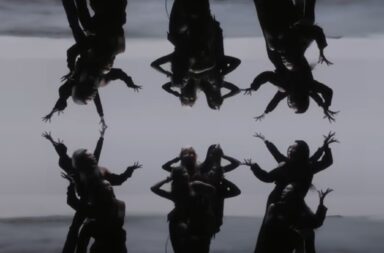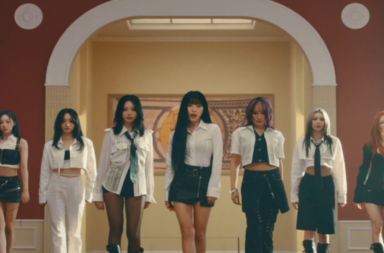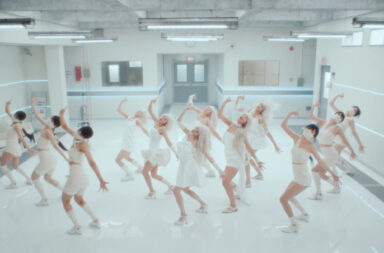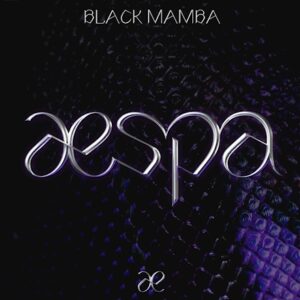
While this year has seen much of the world come to a complete standstill, it has been nothing but the opposite for SM Entertainment. Of all the major labels, few have been as consistently productive as they have, and as we finally approach the year’s end, the 25-year-old company founded by Lee Soo-man has only got busier. Amid successful comebacks from SuperM, NCT, Taemin and Super Junior, as well as imminent activities from BoA and Exo’s Kai, the company has somehow found time to squeeze in the debut of their first new girl group since 2014, Aespa.
Six years after Red Velvet first debuted with the cheerful and bubbly “Happiness”, SM has pulled together four girls of various nationalities, aged between 18 and 20, to create an edgier and more glamorous counterpart. Under the name Aespa (stylised as æspa), the group debuted last week with “Black Mamba”, a dark fusion of pop, EDM and hip-hop filled with aggressive bass synths and sassy vocals.
The song is nothing out of left field, falling very much in line with girl crush trends set by acts like 4Minute, CLC, Black Pink and Itzy, albeit with the high level of polish we associate with SM productions. Given the long wait and anticipation behind this group, as well as SM’s strong reputation for innovating, it’s somewhat disappointing for “Black Mamba” to fall under such a predictable style and for Aespa’s music to start on such a well-trodden path. That said, the song isn’t bad, so at the very least it forms a safe opening chapter for the group, especially considering that they likely have a long career ahead.

SM hasn’t let us down in the concept and visuals department, however, and Aespa come with as striking a concept and MV as you would expect from the team that brought us NCT’s limitless expansion and Exo’s supernatural powers. Capitalising on current (and in anticipation of future) digital technology developments, the four members, Karina, Winter, Ningning and Giselle, come with virtual alter-egos, who appear in concept photos as illustrated counterparts and in videos as 3D-animated characters. The concept seems heavily inspired by K/DA, another virtual four-member girl group created by Riot Games, which features the voices of (G)I-dle’s Soyeon and Miyeon, and promotes the game League of Legends through K-pop-style songs and MVs.
How Aespa’s virtual characters will interact with their real-life counterparts remains unclear, however, and within the MV they make only very brief appearances as mirrored reflections. The MV is also filled with cryptic, surreal imagery, including a teaser for BoA’s upcoming comeback, which hints at untold secrets and fantastical backstories. Like many companies, SM are investing heavily in the idea of world-building and fictional storytelling through K-pop, and for Aespa it seems they are sowing the seeds of these stories as early as possible.
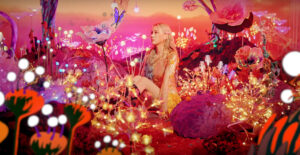
The lyrics of the song incorporate the group’s unique concept, referencing as yet unknown lore from their fantasy world through cryptic words like “Flat”, “Synk”, “Kwangya” and the titular “Black Mamba”. While they aren’t the first to commit to a fiction-based concept this way (TXT’s “Crown” directly tells the story of them growing horns from their heads, for example), using such nonsensical language shows a startling amount of confidence and faith in Aespa’s concept. Rookies from smaller companies might be laughed out of the building for such a boldly strange concept, but SM’s financial and creative investment is always so heavy that, with a little time and refinement, they can almost always convert confusion, scepticism, and ridicule from audiences into feverish enthusiasm and hype. For now, though, we stay with confusion:
From a certain point, you SYNK out
It’s like noise
I can’t find you anymore
What tempted you and swallowed you is
Black Mamba

The MV fleshes out and explains certain parts of this story, though plenty remains cryptic. The members are placed in several fantastical settings, dressed in glitzy, futuristic clothes and decorated with 2D animations. With a mix of purples, pinks and blues, accented with bright neon colours here and there, the MV successfully paints a picture of the alternate universe that Aespa lives in – beautiful, yet surreal, with a blend of ultramodern technology and unnatural nature, suggested through Avatar-inspired plants and flowers, an aurora in the sky and digital glitches and animations scattered throughout scenes.

Over the course of the MV, the world is taken over by a dark force personified through a black mamba snake, presumably the antithesis to Aespa’s sweeter and more feminine protagonist roles. Karina starts in a normal train carriage, before an AirDrop file transfer from an unknown “Black Mamba” transports her to a fantasy alternate universe version filled with flowers. Ningning is casually playing on a multi-screen computer in what looks like a cutesy, futuristic living room, before a virus named “Black Mamba” takes over and wreaks havoc.
This “Black Mamba” then (with impressively convincing CGI) manifests as a real giant snake, slithering around their fantasy world and bringing literal darkness with it. A sudden break in the song gives us a clue as to what’s happening; Karina’s eyes cloud over, and inside her we find a black world where she is controlled by another character, a female personification of the black mamba (played by model Jang Yoon-ju). After this, the world becomes progressively darker and more chaotic, as Aespa face off with their enemy, calling on their virtual counterparts to fight with them and reducing the monster into black slime spattered across the train carriage.
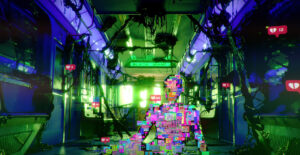
At the end, we get a hint that the “Black Mamba” isn’t completely dead, as it reforms itself from the slime into a menacing humanoid form. This CGI in this scene has the most wow factor, with a mix of 2D glitching and 3D modelling that creates an intriguing and visually powerful cinematic sequence reminiscent of video game cutscenes.
Overall, the special effects in this MV are impressive and tastefully used, to the credit of both the effects team and SM’s budget. The only exception would be the character modelling for Aespa’s virtual counterparts; their appearances and movement feel too awkward and cartoonish to fit with the rest of the visuals, and their appearance momentarily reduces what is otherwise a glamorous K-pop MV to a children’s sci-fi cartoon. Their short cameos reveal a slight amateurishness in the execution of Aespa’s concept (in contrast to K/DA’s relatively convincing production), and it’s uncertain if animation technology and SM’s budget will advance far enough to make them convincing anytime soon.
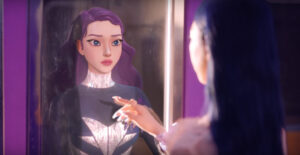
More generally, Aespa’s debut may receive mixed reviews regarding its concept and music, but there’s no doubt that it’s at least interesting. Not many companies approach the art and business of K-pop with as much appetite for innovation as SM does, and the industry overall benefits from the many new ideas that SM throws at it. Without risk-taking ventures like these propelling K-pop’s trends forward, away from overdone concepts and into unexplored territory, the genre has a tendency to stagnate, as we have seen happen several times before. As we fully immerse ourselves in the new decade, surrounded by possibly the highest oversaturation of K-pop ever seen, it’s about time for something new, and after six years of waiting, SM are here to deliver it.
(YouTube [1]. Lyrics via Pop!Gasa. Images via SM Entertainment.)
